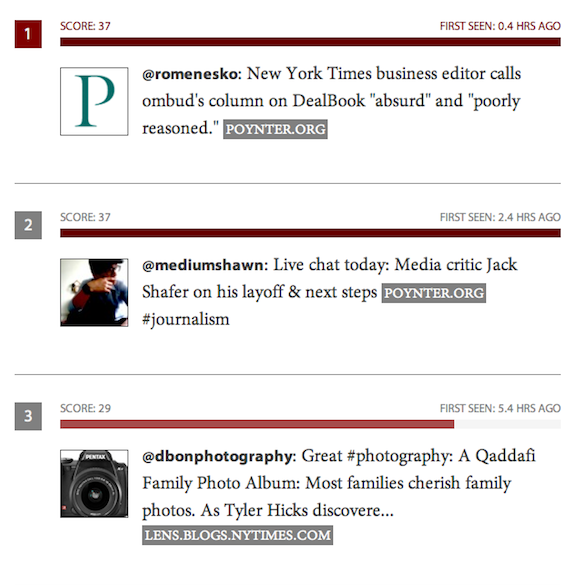We launched a redesign of the Nieman Journalism Lab last week, and the response has been gratifying. Hope you like it. But we were still working on a few new features when we shipped — things we just didn’t have time to finish before letting it loose into the wild. Today I’d like to tell you about three of them; we’ll have a few more in the coming weeks.
We’ve had a great reaction to Fuego, our heat-seeking Twitter bot. Every hour, it pans through the future-of-news twitterverse, searching for the most-talked-about links, doing some math, and presenting the 10 stories at the center of the discussion at that moment. You can see Fuego right on our homepage, just below our own top stories. But we wanted to be able to present Fuego in a few other formats, too.
First, Fuego now has its own dedicated page — providing one scannable place to see all the top stories. We’re also presenting a little more metadata about the stories: the score our algorithm gives the piece (a combination of freshness, popularity, and authority, represented by each story’s red bar), and “first seen,” a notation of when the link first appeared in our crawling of Twitter.

Second, you can follow Fuego on Twitter, at @niemanlabfuego. Whenever a link breaks through into the upper reaches of Fuego’s ranking, it’ll be tweeted automatically to that account. It’s a good follow to keep up with what people are talking about — and it’s an excellent complement to our much more established (nearly 60,000 followers) @niemanlab account.
And third, you can now subscribe to Fuego by RSS and get the same selection of links as the Twitter account, but with the headline and excerpt from each page. Here’s the feed to subscribe to.
Speaking of @niemanlab…most of our readers know we use the account to provide a curated guide to the day’s most interesting news. (No bots there — all human, hand-chosen by our staff.) Since we launched in 2008, that Twitter feed has chronicled the ups and downs of the news industry, technology, and the intersection therein.
Unfortunately, Twitter’s limited search capacity isn’t much use if you want to find anything more than a day or two old. And Twitter’s own APIs only give us access to our 3,200 most recent tweets — we’re approaching 10,000.
So we built a searchable archive of @niemanlab tweets. I know we’ll find it useful in the Lab, but I think there’ll be others out there who’ll use it as a resource to dig into some recent journalism/nerd history. If you’re looking for information about CNN, you can find our 25 stories tagged “CNN” and our Encyclo entry on CNN — but now you can also find our 56 tweets mentioning CNN, which cover a wider piece of turf.

You can get to our Twitter archive by clicking “Twitter” in our top nav menu. Plus, all search results pages on our main site now include a link offering to do the same search against our tweets.
And finally: We got overwhelmingly positive reactions to our redesign. (Like, surprisingly so — I know redesigns are controversial things.) But there was one vocal complaint about our switch from a blog-format front page to the current magazine-ish style: Some people love reverse-chronological format. They love knowing that the most recent post will be at the top of the page.
In truth, we didn’t step too far away from reverse-chronological. The top eight articles on the front page are our eight most recent; anything published in the last 24 hours gets a green bar atop it saying how recent it is. And, with the exception of the left-hand slot on the front page, which is reserved for something we think has good art, the other seven slots are in strict reverse-chronological order — most recent at the top of the middle column, then flowing down that column, then down the right column.
But some people, understandably, want the latest up top. So, for them, we built Nieman Lab Wire, which is nothing more than every post we publish in reverse-chronological order.
We’re not done — there are a few more features and tweaks coming in the next couple of weeks, so stay tuned. (One hint: mobile.) Meanwhile, I’d love to hear your thoughts about what we’ve done or what you think we should be doing.